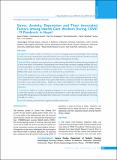Please use this identifier to cite or link to this item:
https://hdl.handle.net/20.500.14356/1473| Title: | Stress, Anxiety, Depression and Their Associated Factors among Health Care Workers During COVID -19 Pandemic in Nepal |
| Authors: | Pandey, Apsara Sharma, Chandrakala Chapagain, Ram Hari Devkota, Narmada Ranabhat, Kamal Pant, Suman Adhikari, Kriti |
| Citation: | PandeyA., SharmaC., ChapagainR. H., DevkotaN., RanabhatK., PantS., & AdhikariK. (2021). Stress, Anxiety, Depression and Their Associated Factors among Health Care Workers During COVID -19 Pandemic in Nepal . Journal of Nepal Health Research Council, 18(4), 655-660. https://doi.org/10.33314/jnhrc.v18i4.3190 |
| Issue Date: | 2020 |
| Publisher: | Nepal Health Research Council |
| Article Type: | Original Article |
| Keywords: | Anxiety Associated factors Depression Health workers Stress |
| Series/Report no.: | Oct-Dec, 2020;3190 |
| Abstract: | Abstract Background: Frontline Health Care Workers are at risk of developing mental and psychological distress during Corona virus disease 2019 pandemic. This study aimed to assess level of stress, anxiety, depression and their associated factors among health care workers during Corona virus disease 2019 pandemic in Nepal. Methods: This is a web based cross-sectional survey conducted among 404 Health Care Workers during early phase of Corona virus disease 2019 pandemic. The participants were selected using convenience sampling technique and were invited to participate via various online networks. Depression, anxiety and stress were assessed using the Depression Anxiety Stress Scale-21 (DASS-21) and their associated factors were measured using structured questionnaires. Multivariable logistic regression was carried out to determine the associated factors. Results: The symptoms of stress, anxiety and depression among health care workers were found to be 28.9%, 35.6% and 17.0% respectively. Females were found to be 2 fold more likely to have anxiety and depression than male. Nurses were found to be two times more likely to have anxiety than doctors. Laboratory personnel were almost three folds more likely to have anxiety than doctors. Health care workers with insufficient/ no PPE were almost three fold more likely to have depression. health care workers working in high-risk areas had almost 2 fold higher odds of having depression. Conclusions: Health care workers experienced symptoms of stress, anxiety and depression in varied level of severity. This experience was higher among the nurses and laboratory workers than doctors. Pandemic preparedness assuring PPE and appropriate psychological interventions may be beneficial to promote mental health and well-being of health care workers. Keywords: Anxiety; associated factors; depression; health workers; stress |
| Description: | Original Article |
| URI: | http://103.69.126.140:8080/handle/20.500.14356/1473 |
| ISSN: | Print ISSN: 1727-5482; Online ISSN: 1999-6217 |
| Appears in Collections: | Vol. 18 No. 4 (2020): Vol. 18 No. 4 Issue 49 Oct-Dec 2020 |
Files in This Item:
| File | Description | Size | Format | |
|---|---|---|---|---|
| 3190-Manuscript-19995-1-10-20210122.pdf | Fulltext Download | 228.35 kB | Adobe PDF |  View/Open |
Items in DSpace are protected by copyright, with all rights reserved, unless otherwise indicated.
